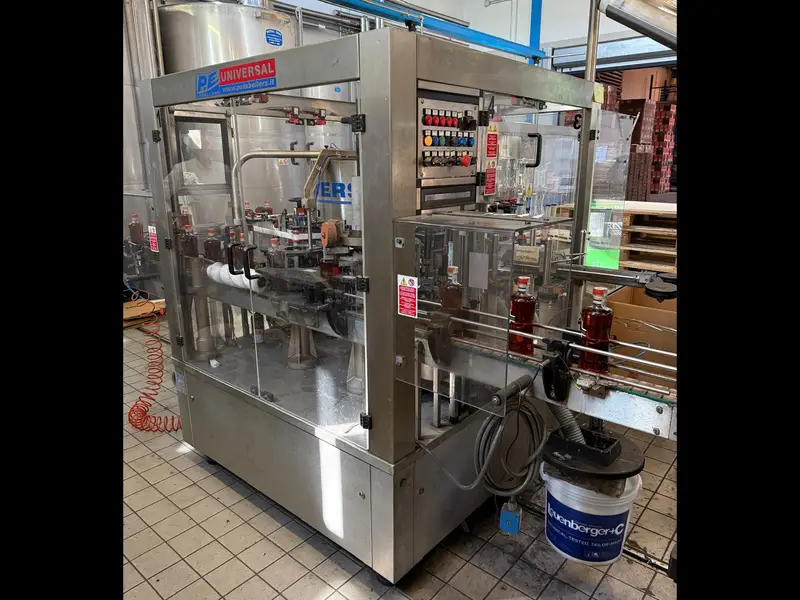Used Bottling Line 12/16/1 Still Products in Glass 2800 bph
The Used Bottling Line 12/16/1 Still Products in Glass 2800 bph is an integrated bottling solution engineered for the precise and efficient handling of still wines, spirits, liquors, and other non-carbonated beverages. This line combines mechanical robustness with industrial-grade flexibility, allowing producers to process a wide range of glass bottle formats and closures at a consistent output of up to 2,800 bottles per hour.
At the core of this bottling line is a triblock monobloc system composed of three main operational modules: rinsing, filling, and capping. The design philosophy prioritizes reliability, hygiene, and ease of maintenance, with all product-contact surfaces manufactured from high-quality stainless steel to ensure compliance with rigorous food safety standards. The line is fully automated and equipped with a continuous conveying system, including transfer conveyors, curves, and motorized sections, enabling seamless movement of bottles through every stage of the bottling process.
This bottling solution is particularly suited for applications where product integrity and presentation are paramount, such as premium wines, distilled spirits, liqueurs, and specialty non-carbonated beverages. Its versatility also extends to other liquid food products compatible with gravity filling technology and traditional glass packaging.
Filling, Capping, and Capsule Application Systems
The filling module within the Used Bottling Line 12/16/1 Still Products in Glass 2800 bph employs a gravity-based level filling system, specifically engineered for non-carbonated products. Bottles are introduced onto a rotating carousel, where each container is securely gripped and positioned beneath a dedicated filling valve. The filling process is controlled by the physical level, ensuring each bottle is filled precisely to a consistent visual point, regardless of minor variations in internal volume. This technique is widely recognized for its accuracy, speed, and gentle product handling—key considerations for preserving the sensory qualities of wines and spirits.
The gravity-level filling system operates without the need for counterpressure, making it particularly effective for still products that do not contain dissolved gases. The filling station is constructed entirely from stainless steel, with each valve and contact surface designed for hygienic operation and easy cleaning. Manual adjustments enable the accommodation of a variety of bottle shapes and sizes within the specified range, offering flexibility for different product lines or seasonal production changes.
Capping is managed by a dedicated turret, integrated within the triblock structure, designed to apply T-type closures—a closure style commonly used for spirits, fortified wines, and certain specialty liquors. The capping station is synchronized with the filling carousel for precise, reliable closure application, using mechanical or pneumatic actuation as required by the bottle and cap specifications. This ensures a secure seal and proper closure alignment, maintaining both the preservation and visual appeal of the product.
Immediately downstream, a monotesta capsule application system applies heat-shrink or transparent capsules to the neck of each bottle. This station utilizes a single-head mechanical applicator designed for consistent, uniform application of capsules, which are then heat-sealed or fitted as required by the capsule material. This finishing touch is essential for the protection, authenticity, and presentation of premium beverages, offering tamper evidence and a professional aesthetic that meets market expectations.
Labelling and Conveying Solutions
Labelling operations on the Used Bottling Line 12/16/1 Still Products in Glass 2800 bph are performed by a rotary labelling machine equipped with multiple application stations. The configuration includes three self-adhesive labelling units and one glue-based station, supporting both contemporary pressure-sensitive labelling and traditional glued seals. The three self-adhesive modules allow for the simultaneous application of main body labels, back labels, and additional elements such as neck or medal labels, maximizing design flexibility and production efficiency.
The glue-based labelling station is engineered for the application of L-shaped seals or tax strips, commonly used for wines and spirits subject to regulatory or branding requirements. Each labelling station operates in harmony with the bottle carousel, using mechanical guidance and precision sensors to ensure exact positioning and wrinkle-free application. The modular labelling machine is constructed from stainless steel and engineered polymers for durability, and features manual adjustments for rapid format changes and routine maintenance.
The integrated conveyor system includes straight sections, curves, and transfer modules, all driven by industrial-grade motors and equipped with stainless steel or plastic chains appropriate for glass bottle handling. The conveyor layout is designed to maintain smooth, continuous flow of bottles between each processing module, with accumulation zones and sensors for automatic line control. This minimizes bottle-to-bottle contact and reduces the risk of breakage or scuffing, a critical consideration for high-value glass packaging.
Each station along the conveyor is fitted with guardrails, access doors, and safety interlocks in accordance with modern safety standards. Maintenance points are accessible without major disassembly, and the open layout facilitates visual inspection and routine sanitation. The electrical and pneumatic systems are logically arranged for straightforward troubleshooting and service.
The bottling line’s automation is managed by classic electro-mechanical control panels equipped with pushbuttons, selector switches, and status indicators. The absence of complex touchscreen HMIs is balanced by the straightforward, robust nature of the controls, which are designed for reliability and simplicity in day-to-day operation.

